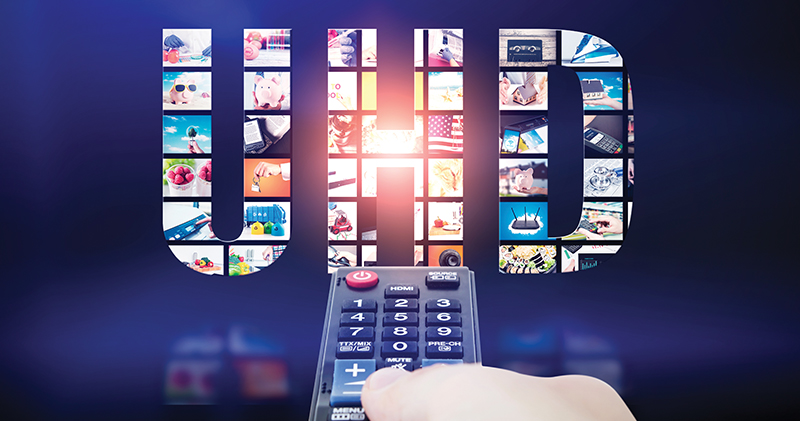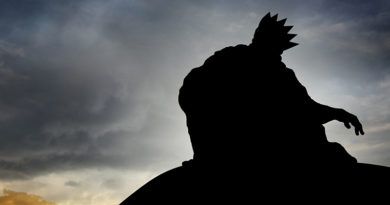UHDTV — Last Part
By the PHANTOM
Well, shoot, I can’t stay on subject long enough to finish a thought. This started out as a one-issue summary of the conversion from HDTV to UHDTV and this is the third installment of the one installment discussion. Some people say it is ADHD, but I say it is the plethora of exciting things to learn today. Take your choice of explanations.
Anyway, the topic is how TV stations transitioned from analog TV to today’s HDTV (ATSC-1), and how they are beginning the transition from HDTV to UHDTV (ATSC-3). The earlier transition started with the adoption of ATSC-1 in 1993. It was June 12, 2009, about 16 years, before analog transmitters were shut off in the US. The way that transition was accomplished was to “lend” each TV station a second channel for the duration of the conversion. One channel carried the station’s normal analog signal and the other the digital HDTV signal. After the transition, the analog transmitters were turned off and one of the two frequencies each station had was returned to the FCC. Of course I’m oversimplifying the process, as there has been a lot of moving of channels besides what I say here.
Now fast-forward to today and we want to change to yet another incompatible TV format. But the channels loaned to the TV stations have been repurposed so the two-channel trick is not available. But we can use some of the characteristics of HDTV to make the transition to UHDTV practical. Channel numbers are now virtual and not literal. In the analog days the channel number was tied to a physical frequency band. If a station identified as channel 2, then you knew it was transmitting on the band from 54 MHz to 60 MHz. Period. Now that same channel 2 may be transmitting on physical channel 31 (572 MHz to 578 MHz) but identifying as channel 2, because that is what viewers are accustomed to. The TV set has a table equating the channel number displayed (ch 2 in our example) to the frequency (ch 31, 572 MHz to 578 MHz). Population of the table is done with information sent on the transmitted signal. This why you rescan your TV from time to time, so that any changes in channel allocations are picked up.
The other feature we are using today is that there is a high enough data bandwidth for several programs on one channel, not just one, and even more bandwidth is available in UHDTV. The channel table is populated with all programs being transmitted. When TV stations in a particular market add UHDTV, they cooperate with each other as follows. Suppose channels A, B, C, D, and E want to add the so-called ATSC-3 signal. Temporarily (maybe) channel C will carry ATSC-3 signals for all five stations. Channel C’s ATSC-1 signal might now go on channel A’s transmitter along with however many auxiliary channels A carries. Channel C’s C.2 program may go to channel E’s signal and so on. All of this is invisible to the viewer, so long as the viewer rescans his TV. All five stations put their ATSC-3 signal on channel C’s transmitter, since it is not carrying any ATSC-1 programs now, and there is even more bandwidth available with ATSC-3. Some such conversions have been going on for two years or more, and some ATSC-3 compatible TVs are in the market.
If you want to look at the ATSC-3 conversion, get yourself a TV that can tune ATSC-3 as well as ATSC-1. Or if you’re cheap like The Phantom, get yourself a tuner that does both and watch it on what you have now. I’m not endorsing (nor not-endorsing) this tuner, but you can find one at https://www.silicondust.com/. The tuner is sold through the usual suspects in consumer electronics.
Theoretically, if and when ATSC-3 supplants ATSC-1 in consumers’ homes, then each station will convert its transmitter to ATSC-3 and drop ATSC-1 transmissions, the process being invisible to viewers except for the need to rescan the TV. Will this really happen? This Phantom is not so sure it will. We kinda think that stations will like the economies of shared transmitters more than they will like the ability to transmit more programs, so they will stick with the transition model of a shared transmitter. Maybe it’ll only be two or three stations sharing (so that each can transmit several programs), but methinks the economics of sharing will be with us after this Phantom is haunting a different industry.
 The Phantom
The Phantom
the.phantom@youwontfindmeanywhere.com
You never know when The Phantom is standing right beside you. Sometimes he is in a meeting with you or walking the floor at your favorite cable show. Sometimes he’s hanging with the suits and other times with the front liners. But be assured, The Phantom sees all, The Phantom knows all and, most importantly, The Phantom tells all.
Shutterstock




